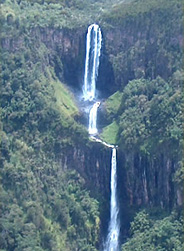
Aberdare Range
About this schools Wikipedia selection
SOS Children have produced a selection of wikipedia articles for schools since 2005. See http://www.soschildren.org/sponsor-a-child to find out about child sponsorship.
The Aberdare Range (formerly, the Sattima Range, Kikuyu: Nyandarua) is a 160 km long mountain range of upland north of Kenya's capital of Nairobi with an average elevation is 11,000 feet (3,350 m). It is located in west central Kenya, northeast of Naivasha and Gilgil and just south of the Equator. It forms a section of the eastern rim of the Great Rift Valley running from the Kinangop Plateau, to the Laikipia Escarpment, roughly north to south. On the east, the range falls off steeply into the Great Rift Valley and views of Lake Naivasha and the distant Mau Escarpment can be seen.
The Aberdare Range has an average elevation of 12,000 - 13,000 feet above sea level and is heavily-forested. Much of the range has been protected within the Aberdare National Park since its creation in 1950. The range attracts large numbers of hikers and climbers, operating out of the main centers of Naivasha and Gilgil. The lower slopes are farmed, while higher areas are known for their wildlife. The Rhino Charge is an annual event run by conservationists in Kenya to pay for fencing off the Aberdare National Park as a means of protecting East Africa's largest indigenous forest from destruction.
The former name of the range survives still in Oldoinyo la Satima ("the mountain of the young bull"); at 4,001 meters (13,120 feet), it is the highest peak in the Aberdare Range. Mount Kenya (5,199 m, 17,057 ft), the second highest mountain in Africa (after Kilimanjaro), lies several kilometres east of the Aberdare Range.
The area is well known as the headquarters of Dedan Kimathi, leader the 1950s Mau Mau Uprising. Also, Queen Elizabeth became Queen of the United Kingdom while vacationing in the Aberdares. It was also the site where J.A. Hunter killed the Rogue elephant of Aberdare Forest.
Geology
The Aberdares are the water catchments for the Sasumua dam and the Ndakaini dam, which provide most of the water for Nairobi. The mountain forests are catchment areas for the Tana River, the largest river in Kenya, supplying water to the Seven Forks hydropower plants generating over 55 percent of Kenya’s total electricity output.
Ecosystem
The main ecosystems within the mountain range are the rainforest giving way to dense bamboo forests and then to moorland. The steep western edges of the hillside is sparsely inhabited by wildlife compared the forested gentle slopes to the east which is home to a wide variety of wildlife. There are multitudes of elephant, buffalo, giant forest hog as well as the endangered Black Rhino. A variety of cats can be spotted including leopards and the rare African Golden Cat. Other threatened fauna can be found, including the Jackson mongoose. The black and white Colobus monkey and Sykes monkey are plentiful , as are waterbuck, reedbuck, duikers, serval cats and bushbuck.
The Aberdares contain a rich diversity of vegetation. There are 778 vegetation and plant species, subspecies and varieties found in the Aberdare National Park, due to the park's the altitude and rainfall. Hardwood trees include camphor, Cedar, Podo and Hagenia.

